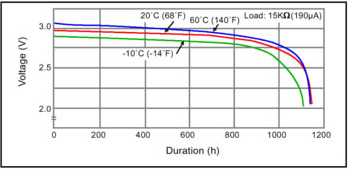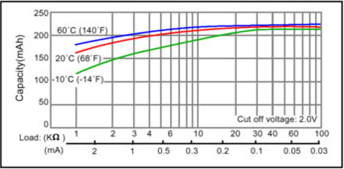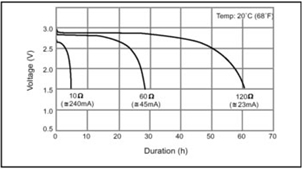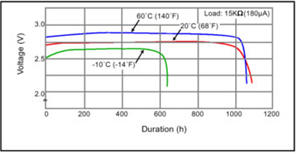Lithium Batteries manufactures custom lithium primary battery packs and assemblies for a wide range of applications. Our experienced battery design team optimizes the reliability, manufacturability, and safety of your custom battery packs by using advanced mechanical and electronic design techniques. With this process, we offer our customers the most reliable and economical lithium primary battery pack solutions.
Request a quote for the custom lithium battery packs you need. For more information or to view individual product specifications, please contact Lithium Batteries.
Custom lithium battery packs and assemblies
Despite having open circuit voltages (OCVs) between 2.7 and 3.6 V, lithium primary cells have a relatively high impedance, which limits their use to low power applications. For certain applications, high-speed discharge cells are available.
Lithium primary batteries often have a wide operating temperature range, and can operate at temperatures ranging from -55 °C to 150 °C (67 °F to 3002 °F). While lithium batteries can be catastrophically damaged by burns or extremely high temperatures, other types of batteries often react similarly.
Lithium primary battery packs come in a variety of chemical compositions, each with its own performance and safety characteristics. It is recommended to use poly (carbon monofluoride) lithium or (CF) X-Li, manganese dioxide lithium or MnO2Li, thionyl chloride-lithium or SOCl2Li, and sulfur dioxide lithium, SO2Li for short.
Lithium manganese dioxide batteries and assemblies customized to meet your needs
In terms of energy density, construction, safety, and OCV, manganese dioxide lithium cells are similar to poly (carbon monofluoride) cells, but they generally last about half as long. In spite of this, MnO2Li cells are well suited to applications requiring relatively high continuous or pulsed current requirements due to their lower internal impedance.
Customized lithium manganese dioxide batteries and assemblies
Manganese dioxide lithium cells are similar to poly (carbon monofluoride) cells in terms of energy density, construction, safety, and OCV, but tend to last about half as long. Because their internal impedance is lower than that of other chemicals, MnO2Li cells are well suited for applications requiring relatively high continuous or pulsed current requirements.
Manganese dioxide lithium battery specifications
Lithium manganese dioxide batteries are available in many standard cylindrical and coin sizes.
- Voltage of the cell: 3.0 V (nominal)
- The capacity ranges from 30mAh to 5Ah
- Energy by volume: (230 Wh / kg); 9.0 Wh / in 3 (550 Wh / L)
- Energy by volume: (230 Wh / kg); 9.0 Wh / cubic feet (550 Wh / liter)
- In terms of energy per pound, it can range from 105 Wh/lb
- depending on the configuration of the cell.
- Charging characteristics: Flat (stable voltage) discharge curves
At 20 °C (68 °F), shelf life is more than 10 years. - Temperature range: -20°C to 60°C (-4°F to 140°F)
- Variable sizes
The batteries are generally used in applications that require small, high capacity batteries, such as: For example, security transmitters, smoke detectors, cameras and photo equipment, computer peripherals, communication devices, personal organizers, memory backup, and lighting.
 |
 |
| Typical discharge at different temperatures for a typical 20 mm x 3.2 mm LiMn02 button cell | Voltage vs. discharge load for a typical 20 mm x 3.2 mm LiMn02 button cell |
 |
 |
| Capacity vs. discharge load for a typical 20 mm x 3.2 mm LiMn02 button cell | Discharge characteristics for a typical 17mm x 28mm LiMN02 spiral cylindrical cell |
 |
|
| Discharge vs. temperature for a typical cylindrical LiMn02 spiral cell measuring 17 mm x 28 mm |
Custom lithium poly carbon monofluoride batteries and assemblies
Poly (carbon monofluoride) cells are an excellent solution for low flow, long-term applications. Their OCV is 3V and their energy density is quite high. Under extreme conditions, their elastomer seals can fail in front of the housing, allowing the relatively reactive cellular components to escape.
The lithium poly carbon monofluoride cell is available in all standard cylindrical sizes as well as in coin configurations. Spiral cathodes and crimped elastomer seals are used in cylindrical cells.
Specifications for lithium poly carbon monofluoride batteries
- Voltage of the cell: 3.0 V (nominal)
- Battery capacity: 25mAh to 5000mAh
- Weight-based energy: Wh/kg
- Approximately 10 years at 20°C (68°F)
- The operating temperature range is -20 ° C to 60 ° C (-4 ° C to 140 ° F), specialty -40 ° to 85 ° C (-40 ° to 185 ° F).
- Variable sizes
- The following applications are possible: pocket calculators, cameras, compact and energy-saving wireless applications, electronic clocks (digital and analog), memory backup in electronic devices (with tab terminals).
For more information, contact Lithium Batteries or request a quote.
 |
 |
| Typical discharge at various temperatures for a typical 20 mm x 3.2 mm (BR) button cell | Voltage vs. discharge load for a typical 20mm x 3.2mm (BR) button cell |
 |
 |
| Capacity vs. discharge load for a typical 20 mm x 3.2 mm LiMn02 button cell | Discharge properties for a typical 17 mm x 28 mm Li spiral cylinder cell |
 |
 |
| Long-term discharge properties for a typical 17 mm x 28 mm Li spiral cylinder cell | Discharge vs. temperature for a typical cylindrical Li spiral cell measuring 17 mm x 28 mm |
Customized lithium thionyl chloride batteries and assemblies
Lithium thionyl chloride cells are best suited to applications with low continuous current requirements and moderate pulsed current requirements. In welded, hermetically sealed housings, these cells have the highest energy density of any lithium type. In all housing types – cylindrical and coin / wafer – the service life is unmatched over 20 years.
Lithium thionyl chloride batteries have an extremely long life and a low self-discharge rate, making them ideal for remote sensing applications. Passive infrared (PIR) sensors used in security systems typically draw very small currents (ten μA) in sleep mode and 7.5 mA to 10 mA during transmission. In these operating conditions, lithium thionyl chloride battery cells offer up to 2.5 times longer service life than either poly (carbon monofluoride) or manganese dioxide lithium batteries.
for lithium thionyl chloride batteries
- Cell voltage: 3.6 V (nominal)
- Capacity: 25mAh to 40,000mAh
- Energy by volume: 1300 Wh / L
- Energy by weight: 710 watt hours / kilogram
- Discharge characteristics: see diagrams below
- Shelf life: 9 years for spiral; 15-20 years for coil (up to 80% capacity)
- Operating temperature range: -40 ° C to 85 ° C (-40 ° F to 185 ° F), specialties -55 ° C to 100 ° C (67 ° F to 212 ° F)
- Sizes: variable
- Applications: GPS Emergency Location / Roadside Assistance, Wireless Security Systems (PIR), Electronic Toll Tags, Tire Tags, Animal Tracking, Asset Tracking, Law Enforcement / Security, Emergency, Utilities and Metering, Deep Hole Drilling, Medical Equipment, Telecommunications
Get a Quote today or contact Lithium Batteries to find out more.
 |
 |
| Operating voltage versus temperature and discharge current for a typical lithium thionyl chloride AA cell with a coil | Available capacity versus temperature and discharge current for a typical lithium thionyl chloride AA cell with a coil |
Customized lithium sulfur dioxide batteries and assemblies
Lithium sulfur dioxide cells are almost exclusively used in military and aerospace applications. It provides slightly less energy density than manganese dioxide lithium or poly (carbon monofluoride) lithium cells, and its energy density and lifetime are generally less than half that of thionyl chloride lithium cells. The hermetically welded housings of these batteries require “emergency” ventilation structures.
Specifications for lithium sulfur dioxide batteries
- Voltage: 3.0 V (nominal), 0.8 V (shutdown)
- N/A Capacity
- Energy per liter: 500 Wh
- Weight-based energy: 290 Wh/kg
- Characteristics of discharge: N/A
- Shelf life: 10+ years (80% capacity or more)
- Temperature range: -60 °C to 85 °C (-76 °F to 185 °F)
- Round cells (typically 1 / 2AA, AA, “C” and “D”)
- Devices that need a high constant current output, long-term storage, high current pulses, and low temperature operation (e.g. military equipment).
Get a quote or contact Lithium Batteries for more information.
Other custom primary lithium battery systems
Besides LiSOCl2 and Li-SO2 cells, there are many other primary lithium cell types. Lithium chemistry offers different technical properties depending on the application.
Lithium iodine cells
Li-I 2 cells offer excellent performance, low self-discharge rates, high reliability, and very high hermetic properties. Pacemakers are among the limited applications of these devices.
Lithium iron sulfide cells
For cells of size AA, Li-FeS 2 have very low self-discharge rates and very high pulse capacities – up to 1.5 amps. Batteries like these are designed for niche markets, such as camera flash systems.
Lithium copper oxide cells
In the mid-1990s, lithium copper oxide and lithium copper oxyphosphate cells ceased production. The use of this chemistry is limited to highly specialized applications today.
Contact Lithium Batteries to discuss custom lithium primary battery packs for your application.